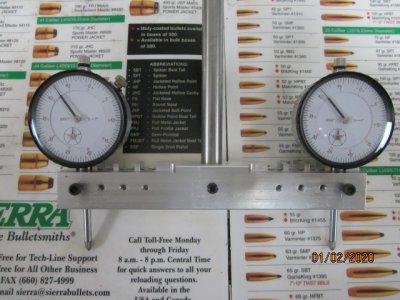- Joined
- Jun 29, 2019
- Messages
- 63
Good Afternoon All,
I am new here having only posted once in the NEWBIE section. What are the specs or what is being used as ok for tramming. I made myself a Tram Gauge that can be used from 3"-6", I'll post a pic below. I want to know what the spec's are or what is acceptable. I have 9x42 1.5 Vari-Speed with Kurt DX-6 and swivel base.
NOD (front to back), I get .0005 using the bed of the vise with the jaws open and my gauge set with the dial indicators 6" apart. On top of the vise either behind the fixed jaw and in front of the movable jaw I get under .001, using the top of the jaws I get under .001 and that's traversing the X handle to read across the top of the jaws or flat areas. On the table left of the vise I get consistently under .001 but much closer to .0005. The right side of the table to the right of vise is get closer to .001. What is good and what is acceptable??
Tramming the table (left and right), with the gauges set a 6" apart on the left side of the vise I get very slight movement between .0005 and .001 but under .001. Right side of the vise on the table I get .001 to .0015. I Shorten the gauges up to 5" apart and check across the fixed jaw on the vise and I get just over .0005. Again what am I looking for.
I did calibrate the gauges and set zero before starting.
Be patient, I'm learning but so far love all the info contained here and the help everyone gives each other . Thanks, Steve
. Thanks, Steve
I am new here having only posted once in the NEWBIE section. What are the specs or what is being used as ok for tramming. I made myself a Tram Gauge that can be used from 3"-6", I'll post a pic below. I want to know what the spec's are or what is acceptable. I have 9x42 1.5 Vari-Speed with Kurt DX-6 and swivel base.
NOD (front to back), I get .0005 using the bed of the vise with the jaws open and my gauge set with the dial indicators 6" apart. On top of the vise either behind the fixed jaw and in front of the movable jaw I get under .001, using the top of the jaws I get under .001 and that's traversing the X handle to read across the top of the jaws or flat areas. On the table left of the vise I get consistently under .001 but much closer to .0005. The right side of the table to the right of vise is get closer to .001. What is good and what is acceptable??
Tramming the table (left and right), with the gauges set a 6" apart on the left side of the vise I get very slight movement between .0005 and .001 but under .001. Right side of the vise on the table I get .001 to .0015. I Shorten the gauges up to 5" apart and check across the fixed jaw on the vise and I get just over .0005. Again what am I looking for.
I did calibrate the gauges and set zero before starting.
Be patient, I'm learning but so far love all the info contained here and the help everyone gives each other
 . Thanks, Steve
. Thanks, Steve